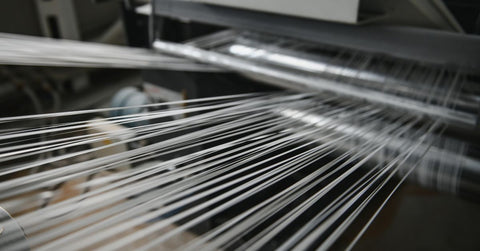Modern marine operations demand materials that deliver exceptional performance under extreme conditions. The constant exposure to saltwater, dynamic loads, and harsh weather requires components that are strong, durable, and reliable.
Technical synthetic ropes have become indispensable assets across the maritime sector, replacing traditional steel wire in many applications. These advanced materials offer a superior combination of strength, weight, and handling characteristics. Find the top uses for technical fiber ropes in the marine industry, while Rocket-Fibers provides a clear overview of their applications and benefits.
Mooring and Anchoring Lines
Securing a vessel, whether it's a massive container ship at port or a private yacht in a quiet cove, is a fundamental task. Technical ropes made from high modulus polyethylene (HMPE) or polyester are now the standard for mooring and anchoring lines.
Unlike steel wire, these ropes are lightweight and flexible, which makes them much easier for crews to handle. This ease of handling improves operational efficiency and reduces the risk of injury. The high strength-to-weight ratio allows for smaller diameter lines with equivalent or greater breaking strength, saving valuable space on deck. Their neutral or positive buoyancy also simplifies retrieval from the water.
Towing and Salvage Operations
Towing and salvage missions involve immense dynamic forces and unpredictable situations. Technical ropes are critical in these high-stakes environments. Aramid fibers, such as Kevlar®, and HMPE provide the ultra-high breaking strengths necessary to tow disabled vessels or recover sunken objects. Their low-stretch properties offer better control and responsiveness during towing.
A key advantage of these ropes is their ability to buffer sudden load changes, which protects hardware and keeps stowing behavior predictable. The light weight of the fiber ropes also means tow lines are easier to deploy, connect, and manage, often with smaller crews and less powerful deck equipment.
Rigging and Lifting
Lifting heavy equipment on vessels, offshore platforms, and in shipyards is a daily operation. Synthetic ropes are increasingly used for crane lines, slings, and other lifting applications. Using a lightweight synthetic rope for a lift means more of the crane's capacity is available for the actual payload, rather than being wasted on the weight of the steel cable itself. This can be especially important for deep-water lifts.
Ropes made from liquid crystal polymer (LCP) offer excellent creep resistance and dimensional stability under load. This capability makes them ideal for stationary rigging and heavy-lift slings where precision is paramount.

ROV and Subsea Umbilicals
Remotely operated vehicles (ROVs) are essential for subsea inspection, maintenance, and construction. The umbilicals that power and control these vehicles often incorporate technical fibers as strength members. These fibers protect the delicate electrical and optical lines inside from the immense tension and abrasion experienced during deployment and operation thousands of feet below the surface.
Aramid and LCP fibers are frequently chosen for their high tensile strength and low elongation. In some cases, synthetic ropes are also used as standalone handling or tether lines for deploying and recovering subsea equipment, as they do not corrode and are easier to manage than wire.
Sailing and Performance Marine
A quest for speed and efficiency drives the world of competitive sailing and performance yachting. Every ounce of weight saved translates to a competitive advantage. High-performance synthetic ropes are standard for running rigging, including halyards, sheets, and control lines.
HMPE ropes, known for their extremely low stretch and light weight, allow for precise sail trim and immediate response. For standing rigging, materials like LCP and aramid provide a stiff, lightweight alternative to traditional stainless steel rods and wire, reducing weight aloft and improving the vessel's stability and righting moment.
Safety and Survival Lines
Safety is the highest priority at sea. Technical ropes play a vital role in life-saving applications. They are used for lifelines, safety tethers, and in man-overboard recovery systems. Their resistance to UV degradation and saltwater means they maintain their integrity and strength over long periods of exposure.
Polyester is often a preferred material for these applications due to its excellent abrasion resistance, stability, strength, and relatively low cost. Using colors in synthetic fibers also enhances visibility, a crucial factor in emergencies.
Selecting the Right Technical Fiber Rope
Selecting the right rope starts with a clear understanding of your application’s demands. Rocket-Fibers offers a range of high-performance solutions tailored for marine environments.

Fiber Type
- UHMWPE: Delivers outstanding strength-to-weight ratio, floats, and resists elongation. Recommended for mooring, towing, winch lines, and performance running rigging.
- Para-aramid (Kevlar®): Provides high tensile strength and heat resistance with low stretch. Suitable for stationary rigging, strength members, and roles with elevated temperature exposure. A protective jacket is advised for extended UV or abrasion.
- LCP (Vectran™): Offers low creep, excellent dimensional stability, and a high modulus, making it ideal for precision load paths, subsea umbilicals, and tethers. Store away from UV light or specify a protective jacket for exposed applications.
- Polyester: Serves as a dependable choice for mooring, anchoring, and all-purpose lines, balancing good strength, abrasion resistance, and value.
- Nylon: Selected where dynamic loads and shock absorption are required, such as anchor rodes and certain towing operations.
Rope Construction
- 12-strand: Lightweight and easy to splice, common in UHMWPE lines for quick handling and efficient winch operations.
- Double braid: Features a strong core and a protective braided cover, ideal for combining high strength with abrasion or UV durability.
- Jacketed and hybrid: Incorporates strength members like UHMWPE, Kevlar®, or Vectran™ under a woven or extruded jacket, well-suited for subsea, umbilical, and standing rigging scenarios needing added protection.
Rocket-Fibers also offers custom coating services for enhanced abrasion, UV, and moisture resistance, as well as precision braiding and twisting options to tailor rope performance to your needs. Our experts can help you select the optimal fiber, construction, and treatment for your specific marine application.
Technical fiber ropes offer a powerful combination of properties to transform maritime operations. Understanding the distinct benefits of different fibers and constructions is key to maximizing performance. The varied and critical uses for technical fiber ropes in marine industries continue to expand as new materials and technologies are developed.
At Rocket-Fibers, our team brings decades of experience to help you select the precise high-performance fiber solution tailored to your specific application.
Vectran™ is a registered trademark of Kuraray Co., Ltd., Japan.


